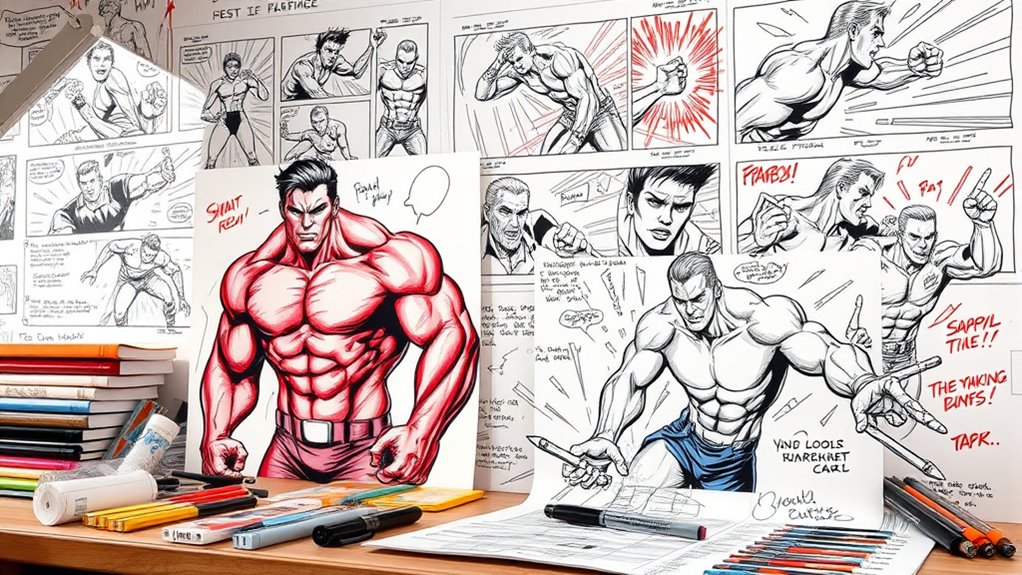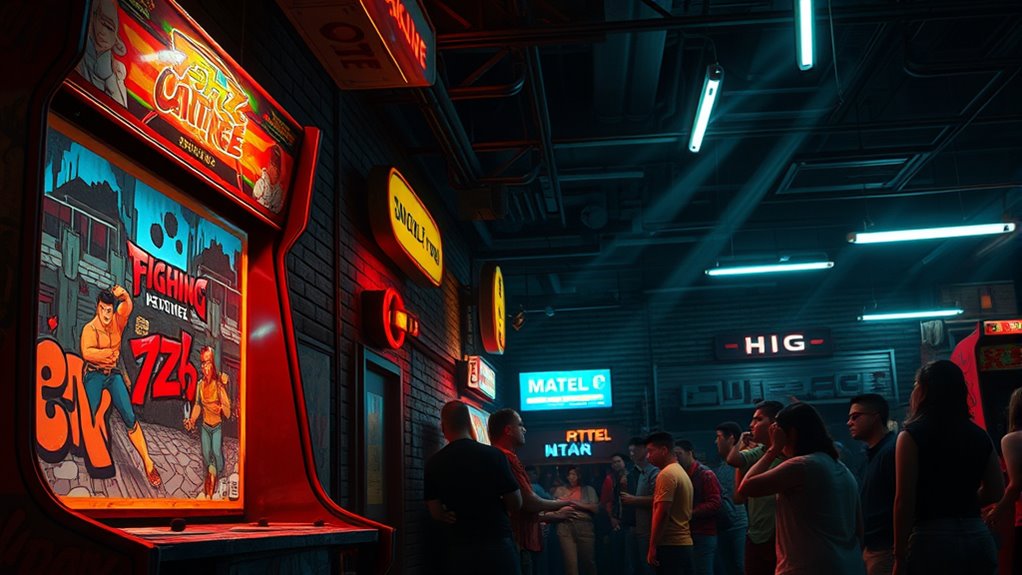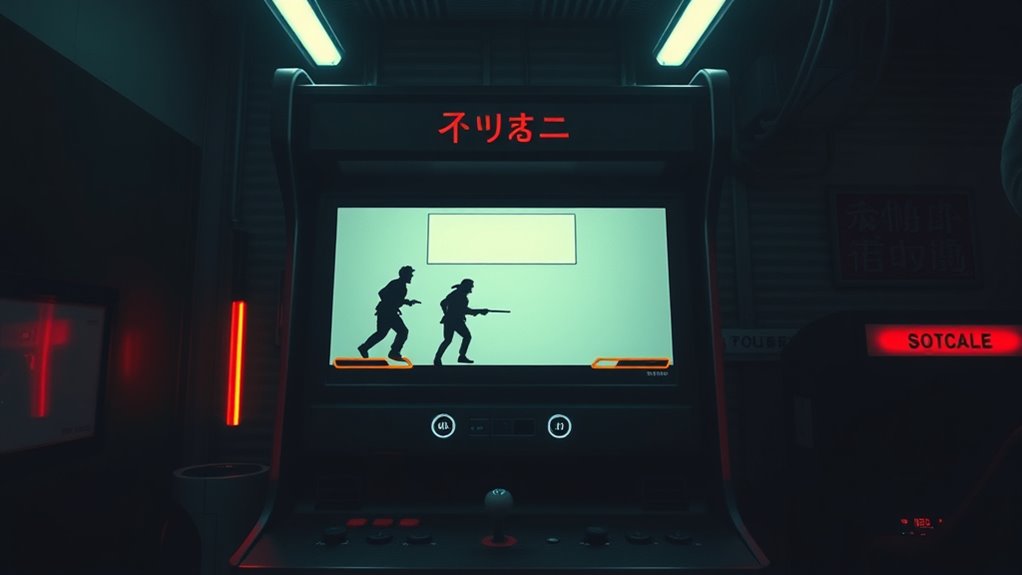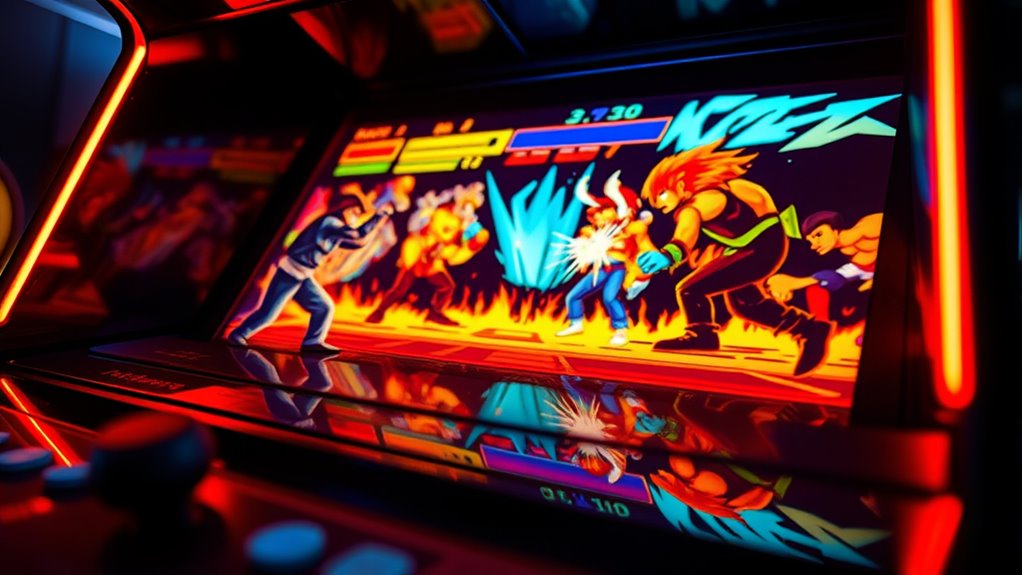In beat ’em up games, storytelling mainly comes from visual character designs that quickly show personality and roles, and environment cues that reflect the story’s tone. You’ll notice sound and music set mood and highlight key moments, while minimalist dialogue keeps the pace flowing smoothly. Character growth is often driven by gameplay choices, making you feel more connected. If you keep exploring, you’ll discover even more ways these techniques turn gameplay into a memorable story experience.
Key Takeaways
- Utilize visual character design to instantly communicate personality, backstory, and emotional cues without dialogue.
- Integrate environment and level progression to reflect story tone and reveal backstory through setting changes.
- Employ sound and music to create atmosphere, highlight key moments, and reinforce characters or themes.
- Use minimalist dialogue and text overlays to efficiently convey story elements and guide player understanding.
- Develop characters through gameplay mechanics, allowing choices and actions to influence their growth and personality.
Visual Character Design as Narrative Devices

Visual character design serves as a powerful narrative device in beat ’em up games by instantly conveying a character’s personality, role, and backstory. Through visual symbolism, you can identify allies, enemies, or leaders at a glance, making the story more immersive. For example, a character’s color scheme, attire, or weapon choices provide emotional cues that hint at their motives or emotional state. Bright colors might suggest heroism or optimism, while darker tones imply menace or mystery. These visual elements help you understand a character’s traits without dialogue, creating an immediate emotional connection. By carefully designing characters with meaningful visual symbolism and emotional cues, developers craft memorable figures who tell their stories through appearance alone, enriching the overall narrative experience. Additionally, understanding emotional support principles can help designers create characters that resonate emotionally with players, fostering deeper engagement.
Level Progression and Environment Storytelling

Level progression in beat ’em up games seamlessly integrates with environment storytelling to create a dynamic narrative experience. As you advance through levels, the changing scenery reflects shifts in story tone and stakes, immersing you deeper into the world. Boss battles punctuate key moments, serving as visual milestones that emphasize story peaks and challenge your skills. Enemy variety keeps encounters fresh, revealing different factions, motivations, and environments. Each level’s design hints at backstory—abandoned warehouses, crumbling city streets, or hidden lairs—adding context to your fight. This combination of environmental cues and enemy design pulls you into the narrative without relying on dialogue, making the environment itself a storyteller that guides you through the game’s unfolding story. Incorporating level design techniques that align with storytelling enhances player engagement and emotional investment.
Use of Sound and Music to Enhance Storytelling

Sound and music play an essential role in shaping the story’s mood and guiding your emotional responses. Ambient soundscapes immerse you in the environment, making each setting feel alive and dynamic. For example, distant sirens or bustling streets can heighten tension or excitement. Musical motifs serve as auditory cues, reinforcing characters or themes as they appear. Recognizable melodies or riffs can signal a villain’s presence or a pivotal moment, creating a sense of continuity. Carefully chosen sound effects, like punches or crashes, add impact and realism. When combined effectively, these elements evoke feelings, emphasize story beats, and deepen immersion. By integrating ambient soundscapes and musical motifs, you transform simple gameplay into a compelling narrative experience. Additionally, utilizing sound recording techniques and equipment can significantly enhance the clarity and emotional impact of your audio design.
Minimalist Dialogue and Text Elements

Even in the absence of extensive dialogue, minimalist text elements can powerfully convey story and character. Using dialogue economy, you deliver essential information without overwhelming players. Short, punchy lines or brief text overlays can highlight key moments, emotions, or plot points efficiently. Text overlays serve as visual cues, guiding players’ understanding without disrupting gameplay flow. This technique emphasizes clarity and focus, allowing players to interpret the story through subtle hints rather than lengthy conversations. Minimalist dialogue encourages players to read between the lines, engaging their imagination. By carefully balancing sparse text with impactful visuals, you create an immersive experience that maintains pacing while still delivering meaningful narrative content. Incorporating visual storytelling techniques from other craft disciplines can further enhance the game’s narrative depth. This approach enhances storytelling without sacrificing the fast-paced energy of beat ’em up games.
Character Development Through Gameplay Mechanics

Gameplay mechanics in beat ’em up games are powerful tools for shaping character development, allowing you to see growth through your actions. Your choices during fights and interactions can reflect moral dilemmas, influencing your character’s evolution. As you face these moments, your decisions impact not just the story but your character’s personality and skills. Incorporating character development into gameplay mechanics encourages players to engage more deeply with their in-game personas. These mechanics encourage you to think about your character’s journey, emphasizing development through gameplay. By engaging with moral dilemmas and making deliberate player choices, you shape your character’s identity, making the experience more immersive and meaningful.
Frequently Asked Questions
How Do You Balance Gameplay Difficulty With Storytelling Clarity?
When tackling difficulty balancing and narrative clarity, you want to guarantee the game challenges players without obscuring the story. You can do this by gradually increasing difficulty, allowing players to understand gameplay mechanics first. Use clear visual cues and concise dialogue to support the narrative. Keep storytelling integrated into gameplay, so players stay engaged without confusion. This way, you strike a balance that maintains both challenge and clarity seamlessly.
What Are Innovative Ways to Depict Story Arcs Without Cutscenes?
You can depict story arcs without cutscenes by leveraging environmental storytelling and visual symbolism. As you progress, incorporate details in the environment that reflect characters’ emotions or plot developments, like abandoned items or environmental changes. Use visual cues and symbolic imagery to subtly convey narrative moments, allowing players to piece together the story organically. This approach keeps players immersed, making storytelling seamless and engaging without interrupting gameplay flow.
How Can Player Choices Influence Narrative Outcomes in Beat ’Em Ups?
You might find it funny how player choices unexpectedly shape your story, almost like a coincidence. In beat ’em ups, you can boost player agency by introducing branching narratives, where your decisions lead to different endings or character paths. This way, each battle feels personal, and your actions directly impact the story’s outcome, making every playthrough unique and engaging without needing cutscenes.
What Role Do Boss Battles Play in Advancing Story Themes?
Boss battles serve as pivotal moments that advance story themes by symbolizing key conflicts and challenges. As you face off against a boss, you witness the villain character development firsthand, revealing their motives and personality. These boss fight symbolism moments emphasize the stakes and themes, making the narrative more impactful. You feel the tension build, and each victory or defeat deepens your connection to the story’s core messages.
How Can Multiplayer Modes Enhance Storytelling Immersion?
You can enhance storytelling immersion through multiplayer modes by leveraging cooperative dynamics, where players work together to overcome challenges, creating a shared narrative experience. Multiplayer pacing allows for dynamic storytelling moments, adapting to players’ actions and decisions in real-time. This interaction deepens engagement, making the story feel more personal and immersive. By fostering teamwork and responsive pacing, multiplayer modes transform gameplay into a collaborative storytelling journey that resonates more deeply with players.
Conclusion
So, next time you’re smashing through pixelated foes, remember: your hero’s story is told through visuals, sound, and a dash of minimalism—because who needs dialogue when you’ve got flashy moves and moody music? Level design and mechanics do the heavy lifting, turning gameplay into a narrative. Ultimately, it’s a masterclass in storytelling without words—proving that in beat ’em ups, silence is truly golden, or at least, gloriously loud.









